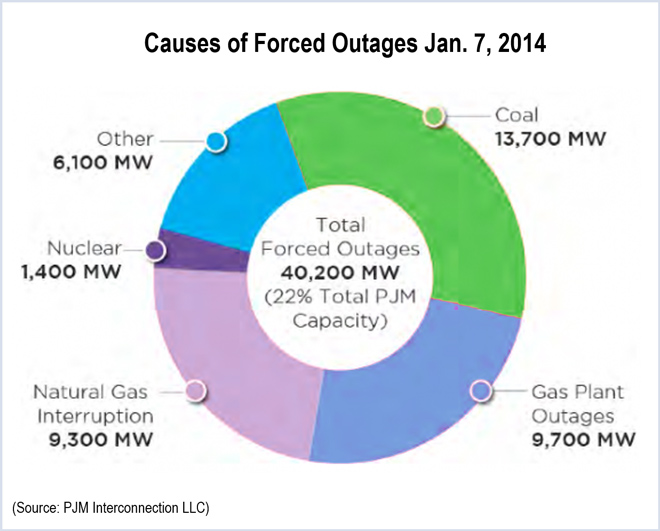By Suzanne Herel
PJM on Friday filed a 37-page response to questions raised by the Federal Energy Regulatory Commission about its Capacity Performance proposal and requested that the board accept the plan effective April 1 so that it may implement the changes in the Base Residual Auction scheduled for next month.
“Despite [their] success in retaining and attracting sufficient capacity to ensure resource adequacy requirements are met, the capacity markets are failing to incentivize adequate generator performance. Resources in PJM have not performed as expected,” PJM said.

“If PJM deferred these changes to the following BRA, held in May 2016 for the delivery year that starts on June 1, 2019, it would mean that the PJM region would let five more winters pass after 2014 without implementing a full remedy to the manifestly deficient performance requirements in the current rules,” it said.
Hoping to Avoid Auction Delay
While the RTO had 30 days to respond to FERC’s March 31 order deeming its Capacity Performance filing deficient, it expedited the reply in hopes it can avoid having to postpone the BRA — something it has never done. However, because of the uncertainty surrounding the new Capacity Performance product — and because the Tariff requires the auction be held in May — the RTO last week requested a waiver to delay the BRA. (See PJM to Respond on Capacity Performance Friday; Seeks Auction Delay.)
PJM said that if FERC does not respond to the waiver request by April 24, the RTO will consider it withdrawn. Meanwhile, it is advising stakeholders to prepare for the auction to be held as scheduled May 11-15.
FERC’s four-page order questioned 10 areas of the proposal, which was conceived to increase reliability expectations of capacity resources with a “no excuses” policy (ER15-623). PJM’s proposal called for larger capacity payments for over-performing participants and higher penalties for non-performers.
FERC asked PJM to explain its derivation of an appropriate competitive clearing price when no new capacity is required in a locational deliverability area (LDA), and to provide more detail on a default offer cap and how it would apply in several situations.
PJM responded in detail, saying “a default Capacity Performance resource offer cap, based on net [cost of new entry] times the balancing ratio, is reasonable and appropriate.”
Balancing Ratio
PJM introduced the balancing ratio to adjust a resource’s committed unforced capacity (UCAP) to reflect its expected performance during Performance Assessment Hours. The proposed ratio would be calculated by dividing total load and reserves on the system by total generation and storage capacity commitments during the Performance Assessment Hour.
Regarding concern raised by some interveners that the balancing ratio is too difficult to estimate in advance, PJM said that if the commission accepts the offer cap agreed upon by PJM and the Independent Market Monitor, it will use a historical weighted average based on the previous three delivery years. During that period, there were 70 hours — including 42 hours of RTO-wide emergency — that would have been Performance Assessment Hours.
“Capacity Performance provides extremely strong incentives for resource availability and therefore, over time, will eliminate occurrences like those seen in the winter of 2014,” PJM said. “As a result, the expected value of the balancing ratio is anticipated to increase over time to a value that is more indicative of the summer Performance Assessment Hours, which averaged around 93.5%.”
FERC also requested any analyses the RTO had conducted on expected performance charges and bonus payments under the proposal. The commission asked if it made sense to phase in the penalties and for ideas of how to provide incentives for resource performance. In addition, it asked PJM how it plans to evaluate the performance of external resources not pseudo-tied to the RTO.
PJM cited the transitional structure it proposed in the plan that would allow PJM and capacity market sellers to adjust to the new product over the two remaining delivery years before 2018/19.
“As such, PJM therefore believes that it is unnecessary to provide further transition into the Capacity Performance structure from the standpoint of the non-performance charge, because load should be assured that Capacity Performance resources have the full incentive to invest appropriately in their resources from the 2018/2019 delivery year forward,” it said. “Phasing in the non-performance charge rate beyond what PJM has already proposed in its transition mechanism would inappropriately dilute this incentive.”

